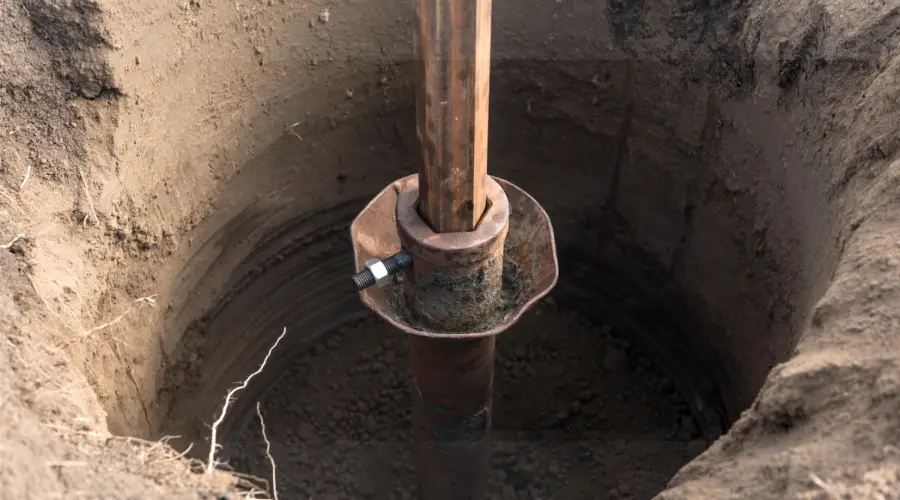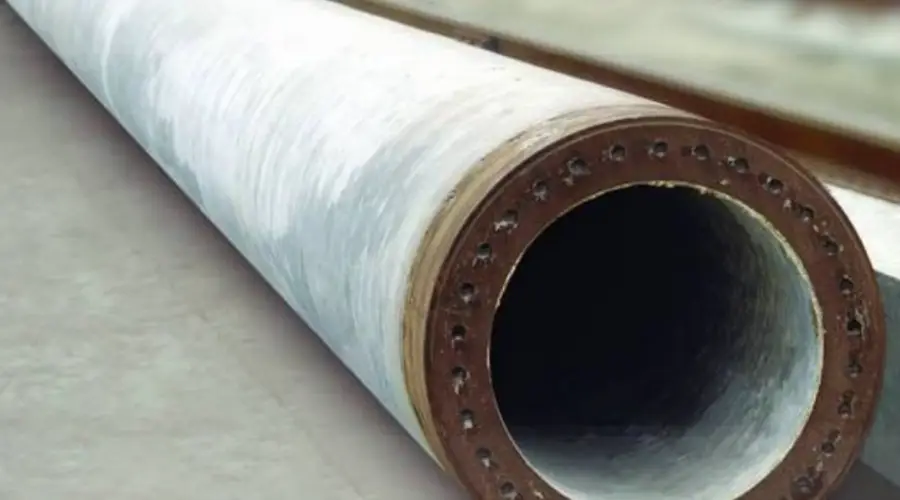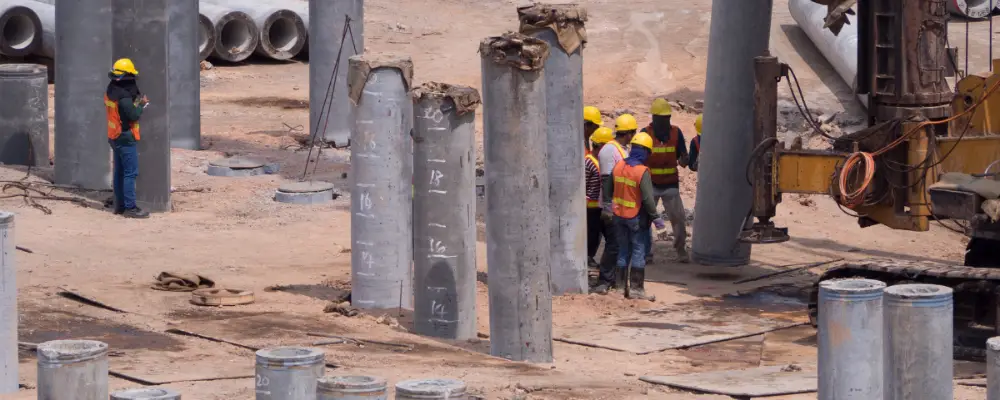The principal constituent that stabilises and transfers the weight of the structures to the ground below is considered the crucial part of all structures, from small-scale constructions to large buildings. Prestressed concrete piles are ideal for supporting bridges and high-rise buildings, ensuring high strength, longevity, robustness, and flexibility. They are a reliable option for contemporary buildings since they lower the chance of structural failure. This article covers their uses, benefits, drawbacks, design considerations, and installation process.
What are Prestressed Concrete Piles?
Prestressed concrete piles are foundations made of concrete strengthened with steel cables, wires, or rods. This adds extra compression to make them stronger. They are commonly used in marine structures, bridges, and buildings because they are strong, long-lasting, and cost-effective.
How Prestressed Concrete Piles are Produced?
Before pouring concrete, steel wires or strands are tensioned within a mold or formwork. Once the steel is tensioned, the high-strength concrete is poured around it. After the concrete cures and gains sufficient strength, the tension in the steel is released, transferring compressive stress to the concrete. This process creates prestressed concrete piles, which are capable of withstanding high tensile forces and loads. Compared to regular reinforced concrete, prestressed concrete is stronger and better for tough structural needs. These piles are usually made off-site and delivered ready for installation.
Applications of Prestressed Concrete Piles

A variety of projects use prestressed concrete piles, such as:
- Multi-story structures: Prestressed concrete piles are involved in assisting multi-story structures and commercial buildings where sturdy, dependable foundations are essential for lifespan and safety.
- Bridges: While constructing bridges, these piles offer piers and abutments steady supports, especially in difficult situations like rivers or soft soils, to maintain structural integrity over many years.
- Maritime structures: Even in tough maritime structures, prestressed concrete piles provide outstanding resistance to saltwater corrosion and wave forces. These piles are essential for increasing the durability of structures in challenging maritime environments.
- Land stabilisation: Especially in regions with steep or unstable slopes, these supporting structures are intended to reinforce the earth and stop landslides and soil erosion.
- Transportation infrastructure: They provide a strong foundation for roads, bridges, and railroads, guaranteeing secure and efficient travel even in the face of heavy traffic.
Advantages of Prestressed Concrete Piles

The following benefits taken together make prestressed concrete piles a top choice for engineers and builders looking for a solid, long-lasting, and effective foundation solution for contemporary infrastructure.
High Load-Bearing Capacity:
Because of the compressive stress applied during manufacturing, prestressed concrete piles are made to support heavy loads. With the help of the prestressing, the piles can carry large weights without breaking or failing since they counteract the tensile strains that form under heavy loads.
Durability:
By keeping the concrete under compression, the prestressing procedure lowers the possibility of cracks developing. Greater resistance to external elements, including moisture, chemicals, and temperature fluctuations, results from fewer cracks.
Decreased Material Usage:
Compared to traditional reinforced concrete, they use less material to accomplish the necessary structural performance by optimising the strength of both steel and concrete. This leads to savings in raw materials and lowers the piles’ total weight, which can minimise transport expenses.
Quality Control:
Precise engineering and stringent quality assurance procedures are advantageous for prestressed concrete piles since they are produced in regulated manufacturing settings. This lowers the possibility of flaws developing during on-site manufacture and guarantees constant strength, durability, and dependability. They thus deliver trustworthy and consistent performance in the field.
Easy Transportation and Installation:
Since they are prefabricated off-site, they are easily transported to the construction site and readily available for use. Their homogeneous quality and standardised design make installation easier and shipping more efficient. These piles are a time-saving and economical option for projects with strict deadlines since contractors can count on rapid deployment and shortened construction timetables.
Disadvantages of Prestressed Concrete Piles
Even though prestressed concrete piles provide significant benefits, several disadvantages also arise during the construction process, as follows:
Increased Initial Costs:
Precast concrete piles are made utilising advanced methods, including tensioning steel strands and employing materials with high strength. When compared to traditional reinforced concrete piles, these procedures raise the initial costs due to the requirement for specialised machinery and controlled manufacturing settings.
Transportation Issues:
Large prestressed concrete piles are expensive and difficult to transport, often requiring specialised vehicles or equipment, particularly for locations that are difficult to reach. Logistics are further complicated by the possibility that their weight and size will impede transportation routes or necessitate permits.
Restricted On-Site Adjustments:
Prestressed concrete piles are not very adaptable once they are produced. Pre-engineered to precise dimensions and strengths, prestressed piles are not like materials that can be readily cut or modified on-site. To prevent expensive delays or replacements, any design modifications or flaws must be fixed before production, necessitating careful planning and precise design.
Installing Prestressed Concrete Piles:
Installing these structural components requires specialised tools, like vibratory drivers or hydraulic hammers, as well as experts who are aware of the nuances involved in handling and positioning them. Particularly in places where such knowledge or tools are not easily accessible, this specialisation may raise project costs and complexity. Additionally, following certain procedures is necessary to ensure correct installation, which might increase the time and effort required.
Design Considerations for Prestressed Concrete Piles
There are numerous important considerations when designing prestressed concrete piles:
- Evaluating the weight and kind of loads that the pile must sustain is known as load requirements.
- To ascertain the diameter and length of the pile, geotechnical studies are carried out to escalate soil conditions.
- Resilience to external factors like salinity or freeze-thaw cycles is a requirement for durability.
- Adhering to national and international regulations to guarantee performance and safety.
- Striking a balance between performance objectives and the costs of materials, manufacture, and installation.
Installation Process of Prestressed Concrete Piles
Site Preparation:
To guarantee a solid working environment, the building site needs to be levelled and cleared before installation starts. This stage entails clearing away any vegetation, rubbish, or other obstacles that could block the machinery or the positioning of the piles.
Pile Driving:
It is a technique that involves driving long and slender piles into the soil or rock using specialised equipment to achieve a strong foundation and load-bearing capacity.
Monitoring:
Constant monitoring is essential to make sure the piles are placed appropriately during the driving operation. Engineers verify pile integrity, penetration depth, and correct alignment. Additionally, monitoring aids in the detection of possible problems like unforeseen resistance or pile damage.
Cutting and Capping:
Once the piles are driven to their full depth, they are often longer than required. Using specialised tools, excess piles are cut to the required length. In order to evenly distribute structural loads throughout the group, pile caps are placed on top of the trimmed piles.
Testing:
Load testing is carried out to ensure that the piles satisfy design specifications. To evaluate the pile’s capacity and settlement behaviour, these tests entail applying weight or pressure. Testing helps find any possible vulnerabilities and confirms that the piles can support the expected loads safely.
For a variety of building projects, prestressed concrete piles offer a strong, reliable, and long-lasting foundation when installed according to this meticulous procedure.
Conclusion
Engineers and contractors can make wise choices to guarantee the success of their projects by being aware of the prestressed concrete pile’s uses, benefits, and installation complexities. Prestressed concrete piles are still a valuable component of sturdy, environmentally friendly buildings.
FAQ’s
They provide greater durability, crack resistance, and load capacity. They are effective for heavy-duty constructions like bridges and maritime structures because of their controlled manufacture, which guarantees quality, and their reduced material consumption.
To make sure the piles satisfy structural requirements, consider the following factors: load requirements, soil conditions, environmental stresses, proper alignment during installation, and thorough testing.

